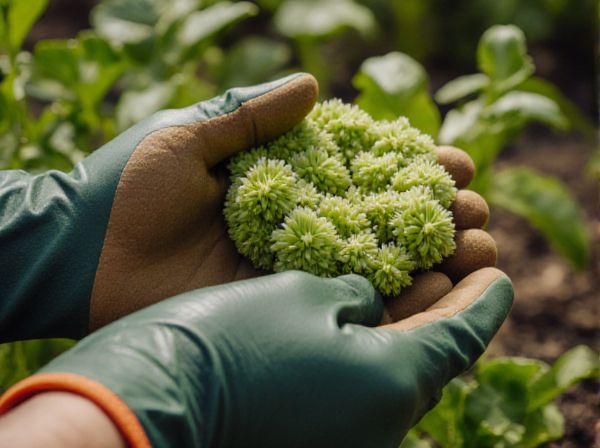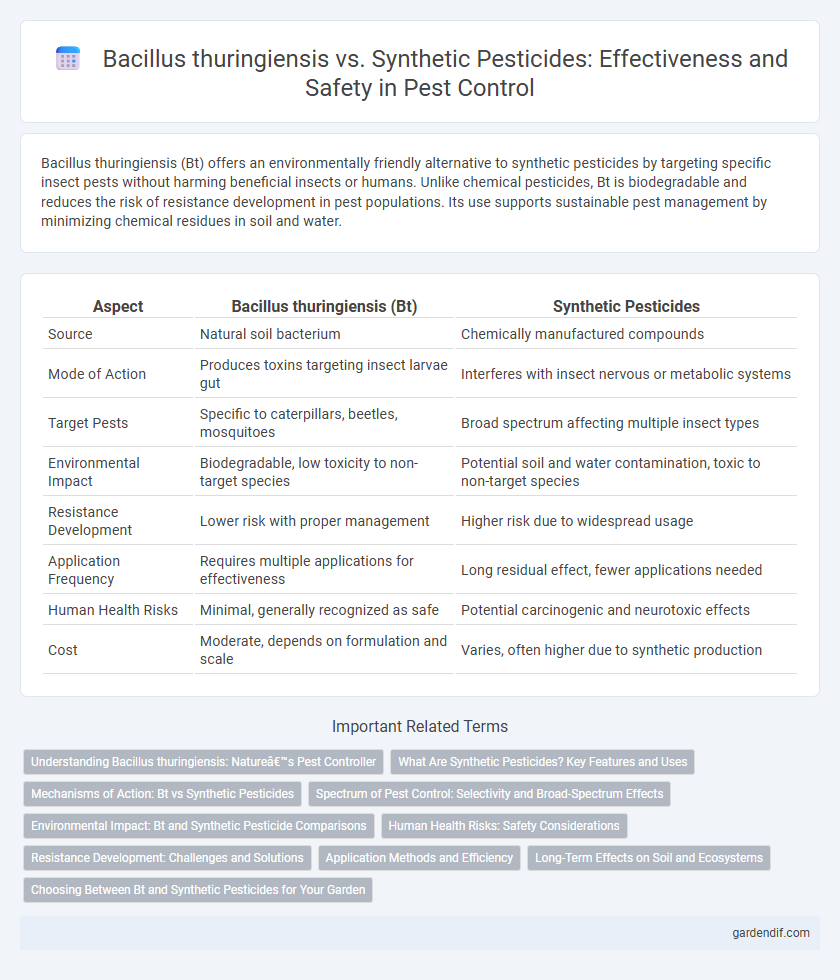
Bacillus thuringiensis vs synthetic pesticides Illustration
Bacillus thuringiensis (Bt) offers an environmentally friendly alternative to synthetic pesticides by targeting specific insect pests without harming beneficial insects or humans. Unlike chemical pesticides, Bt is biodegradable and reduces the risk of resistance development in pest populations. Its use supports sustainable pest management by minimizing chemical residues in soil and water.
Table of Comparison
| Aspect | Bacillus thuringiensis (Bt) | Synthetic Pesticides |
|---|---|---|
| Source | Natural soil bacterium | Chemically manufactured compounds |
| Mode of Action | Produces toxins targeting insect larvae gut | Interferes with insect nervous or metabolic systems |
| Target Pests | Specific to caterpillars, beetles, mosquitoes | Broad spectrum affecting multiple insect types |
| Environmental Impact | Biodegradable, low toxicity to non-target species | Potential soil and water contamination, toxic to non-target species |
| Resistance Development | Lower risk with proper management | Higher risk due to widespread usage |
| Application Frequency | Requires multiple applications for effectiveness | Long residual effect, fewer applications needed |
| Human Health Risks | Minimal, generally recognized as safe | Potential carcinogenic and neurotoxic effects |
| Cost | Moderate, depends on formulation and scale | Varies, often higher due to synthetic production |
Understanding Bacillus thuringiensis: Nature’s Pest Controller
Bacillus thuringiensis (Bt) is a naturally occurring soil bacterium that produces proteins toxic to specific insect pests, making it a highly targeted biological pesticide. Unlike synthetic pesticides, Bt poses minimal risk to non-target organisms, including beneficial insects, humans, and animals, due to its species-specific mode of action. Its biodegradability and reduced environmental persistence contribute to sustainable pest management practices and lower ecological impact compared to conventional chemical pesticides.
What Are Synthetic Pesticides? Key Features and Uses
Synthetic pesticides are chemically engineered substances designed to control, repel, or eliminate pests such as insects, weeds, and fungi. Unlike Bacillus thuringiensis, which is a naturally occurring bacterium targeting specific insect larvae, synthetic pesticides offer broad-spectrum effectiveness and rapid action on diverse pest populations. Key uses include agricultural crop protection, public health vector control, and structural pest management, though concerns about environmental impact and resistance development persist.
Mechanisms of Action: Bt vs Synthetic Pesticides
Bacillus thuringiensis (Bt) targets pest larvae by producing crystal proteins that, upon ingestion, bind to specific receptors in the insect gut, causing cell lysis and death. Synthetic pesticides often use neurotoxic compounds that disrupt pest nervous systems by blocking neurotransmission or enzyme activity, leading to paralysis or mortality. Unlike Bt's highly selective mode of action, synthetic pesticides generally affect a broad spectrum of insects, increasing the risk of resistance and non-target species impact.
Spectrum of Pest Control: Selectivity and Broad-Spectrum Effects
Bacillus thuringiensis (Bt) offers highly selective pest control by targeting specific insect larvae, minimizing harm to beneficial insects and non-target species. Synthetic pesticides typically provide broad-spectrum effects, indiscriminately affecting a wide range of pests and beneficial organisms alike. This specificity of Bt enhances ecological balance and reduces environmental impact compared to synthetic chemicals.
Environmental Impact: Bt and Synthetic Pesticide Comparisons
Bacillus thuringiensis (Bt) offers a targeted approach to pest control, minimizing harm to non-target organisms and reducing environmental contamination compared to synthetic pesticides, which often exhibit broader toxicity and persistence in soil and water systems. Bt's biodegradability and specificity contribute to lower risks of bioaccumulation and ecosystem disruption, making it a more sustainable option for integrated pest management. Synthetic pesticides can lead to resistance development and negatively affect beneficial insect populations, whereas Bt's mode of action slows resistance and preserves ecological balance.
Human Health Risks: Safety Considerations
Bacillus thuringiensis (Bt) is a naturally occurring bacterium widely used as a biopesticide with minimal human health risks due to its specificity to insect larvae and rapid environmental degradation. Synthetic pesticides often contain chemicals linked to acute poisoning, long-term neurological issues, and endocrine disruption in humans. Safety considerations favor Bt because it reduces chemical exposure and associated health hazards, making it a safer alternative in integrated pest management practices.
Resistance Development: Challenges and Solutions
Bacillus thuringiensis (Bt) presents a biological alternative to synthetic pesticides, reducing the risk of resistance development through its specific mode of action targeting insect larvae. Synthetic pesticides often lead to rapid resistance in pest populations due to their broad-spectrum toxicity and repeated use, necessitating integrated pest management strategies. Combining Bt with crop rotation, refuges, and resistance monitoring helps mitigate resistance challenges, ensuring sustainable pest control effectiveness.
Application Methods and Efficiency
Bacillus thuringiensis (Bt) is applied primarily as a biological spray targeting specific insect larvae, offering precision and reduced non-target toxicity compared to synthetic pesticides, which are often broad-spectrum and applied through aerial or soil methods. Bt's efficiency stems from its mode of action, producing toxins that disrupt insect gut cells, leading to effective pest control with minimal environmental impact. Synthetic pesticides typically provide rapid knockdown of pests but can lead to resistance and environmental contamination, making Bt a sustainable alternative in integrated pest management programs.
Long-Term Effects on Soil and Ecosystems
Bacillus thuringiensis (Bt) offers a sustainable pest control alternative by targeting specific insects without harming beneficial soil microbiota, preserving soil health and ecosystem balance over time. Unlike synthetic pesticides, which often lead to soil contamination, reduced biodiversity, and disrupted nutrient cycles, Bt reduces environmental persistence and toxicity risks. Long-term field studies indicate Bt's minimal impact on non-target organisms supports resilient ecosystems, promoting sustainable agricultural practices.
Choosing Between Bt and Synthetic Pesticides for Your Garden
Bacillus thuringiensis (Bt) offers an eco-friendly alternative to synthetic pesticides by specifically targeting pest larvae while preserving beneficial insects and soil health. Synthetic pesticides provide broad-spectrum pest control but often pose risks to pollinators, human health, and environmental balance. Selecting Bt supports sustainable gardening practices and reduces chemical residues, making it ideal for organic or home-based pest management.
Bacillus thuringiensis vs synthetic pesticides Infographic

 gardendif.com
gardendif.com